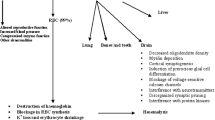Abstract
A principal target for the environmental toxin lead (Pb) is porphobilinogen synthase (PBGS), a Zn-metalloenzyme necessary for heme biosynthesis. Measurement of blood Pb inhibited PBGS is the most sensitive indicator of subclinical Pb intoxication, but problems with the assay have diminished its use. This report identifies Pb as a slow acting inhibitor of PBGS. The activity of PBGS could change up to sixfold during an hourlong clinical assay of Pb contaminated blood, and activity is profoundly effected by the presence of serum proteins, such as albumin. When PBGS catalyzed PBG production is allowed to reach a steady state rate, kinetic data on purified PBGS support the hypothesis that Pb inhibition of PBGS results from direct substitution for Zn.
Similar content being viewed by others
References
S. Koike,J. Nation's Health,28, 612–616 (1959). (Jap)
Y. Tanabe,J. Nation's Health,28, 552–559 (1959. (Jap)
H. C. Lichtman, and F. Feldman,J. Clin. Invest. 42, 830–839 (1963)
H. P. Monteiro, D. S. P. Abadalla, O. Augusto, and E. J. H. Bechara,Arch. Biochem. Biophys. 271, 206–216 (1989) and references therin.
N. Cohen, T.J. Kneip, V. Rulon, and D. H. Goldstein,Environ. Health Perspect. 7, 161 (1974).
D. H. Goldstein T. J. Kneip, V. Rulons, and N. J. Cohen,J. Occup. Med. 17, 157 (1975).
D. C. Wigfield, J-P. Farant, C. Goldberg, and J.E. MacKeen,J. Anal. Toxicol. 5, 57–61 (1981).
J-P Farant, and D. C. Wigfield,Br. J. Indust. Med. 41, 406–411 (1984).
H. Fujita, R. Yamamoto, K. Sato, and M. Ikeda,Toxicol. and Appl. Pharmacol. 77, 66–75 (1985).
T. Sakai, S. Yanagihara, and K. Ushio,Clin. Chem. 26/5, 625–628 (1980).
N. Despaux-Pages, E. Comoy, C. Bohuon, and C. Boude'ne,Int. Arch. Occup. Environ. Health,57, 303–313 (1986).
M. Hellmut, and D. Beyersmann,Enzyme,29, 260–266 (1983).
D. C. Wigfield, and J-P. Farant,J. Anal. Toxicol. 3, 161–168 (1979).
E. K. Jaffe, S. P. Salowe, N. T. Chen, and P. A. DeHaven,J. Biol. Chem. 259, 5032–5036 (1984).
K. D. Gibson, A. Neuberger, and J. J. Scott,J. Biochem. Soc. 61, 618–629 (1955).
P. M. Jordan, and J. S. Seehra, inMethods in Enzymology, Vol. 123, (1986), pp. 427–434, Academic Press, New York.
P. M. Jordan and P. N. B. Gibbs,Biochem J. 227, 1015–1020 (1985).
P. M. Jordan, and J. S. Seehra,J. C. S. Chem. Comm. 240–242 (1980).
J. S. Seehra, M. G. Gore, A. G. Chaudhry, and P. M. Jordan,Eur. J. Biochem. 114, 263–268 (1981).
P. M. B. Gibbs, M. G. Gore, and P. M. Jordan,Biochem. J. 225, 572–580 (1985).
P. N. B. Gibbs, A. G. Chaudhry, and P. M. Jordan,Biochem. J. 230, 25–34 (1985).
N. W. Cornell, and K. E. Crivaro,Anal. Biochem. 47, 203–208 (1972).
I. Tsukamoto, T. Yoshinaga, and S. Sano,Biochem. Biophys. Acta,570, 167–178 (1979).
R. Ravel,Clinical Laboratory Medicine, pp. 485, (1973), Year Book Publishers, Chicago.
P. L. Goering, and B. A. Fowler,Fed. Proc. 46, 2239 (1987).
“Increased Lead Absorption and Lead Poisoning in Young Children,” 1975, A statement by the Center for Disease Control, US Dept. of Health, Education, & Welfare, Atlanta, Georgia.
H. L. Needleman, I. Davidson, E. M. Sewell, and I. M. Shapiro,N. Engl. J. Med. 290, 245–248 (1974).
Author information
Authors and Affiliations
Rights and permissions
About this article
Cite this article
Jaffe, E.K., Bagla, S. & Michini, P.A. Reevaluation of a sensitive indicator of early lead exposure. Biol Trace Elem Res 28, 223–231 (1991). https://doi.org/10.1007/BF02990469
Received:
Accepted:
Issue Date:
DOI: https://doi.org/10.1007/BF02990469




